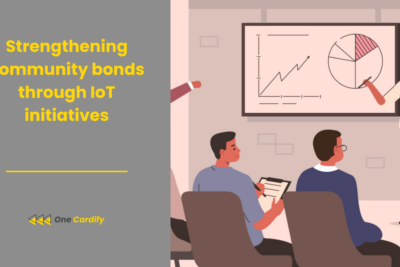
Enhancing rural internet access with IoT
Connectivity in rural landscapes has remained a challenge to many nations. The use of the internet in the countryside is more than just a convenience but a must for the development of the economy, education, and healthcare. This blog article explores the importance of the Internet of Things (IoT) for improving rural internet accessibility, and thus eliminating the digital barrier.IoT makes it possible for the people who live in remote areas to have better internet services that provide them with an opportunity to be innovative, educational and communicative. This debate covers the advantages, ways of IoT technology application and future prospects of using IoT technologies in rural internet improvement.Continue reading to discover how IoT is not only way to modernize cities, but also is a bright light of hope for rural communities that seek connectivity.
Unlocking New Avenues for Rural Connectivity with IoT
Urban-rural digital divide is an internationally acknowledged problem. As with many other cities, high-speed internet is enjoyed though connectivity in the rural areas is limited if not absent. Using IoT to improve connectivity in rural areas is a prospective solution.IoT device works based on the internet connections. IoT solutions such as sensors and connected devices integrated in the rural areas can enable a range of applications from precision agriculture to telemedicine, all of which needed internet access.The integration of technology allows more effective data integration and communication, which directly impacts the improvement of infrastructure and services.For example, weather condition, crop health, and soil moisture data can be monitored by an IoT device, which can give the farmer the needed information despite the vicinity of the location, thereby providing valuable data to the farmers also.
Related content
The Role of Government and Private Sector in Connectivity
IOT in the rural areas is achievable through government and private sector collaboration. Funding, policy making and infrastructure building are required for these initiatives to start.Many countries have initiated schemes to expand broadband and improve internet services in rural areas. These projects usually comprise the use of IoT technologies to help communities to enjoy the benefits.On the contrary, private companies provide the technology and skill required for the successful integration of IoT solutions. Synergies among these sectors coupling can speed up the deployment process and bring rural dwellers the reality of sustainable connectivity.
Challenges and Solutions
However, despite the huge potential of IoT in improving rural internet access, there are challenges. Infrastructure costs, technological literacy, and maintenance are difficult barriers.A solution is to create cost-effective scalable IoT devices that are specifically designed for the rural settings. Other training initiatives targeted at enhancing digital literacy of rural communities can also stimulate the uptake of innovations.Maintenance should be approached by setting up local IoT hubs at which the members of the community are trained to handle and repair the devices, thus ensuring the sustainability.
Case Studies: Success Stories from Around the Globe
Many success stories around the world do tell of the power of IoT in revolutionizing rural connectivity. In remote areas of India, crop yields and water management have been improved by IoT-based projects.In Africa, IoT is utilized for the monitoring of the livestock’s health that has greatly increased productivity in the pastoral community. These examples do not only demonstrate the versatility of IoT but also what it can do to change lives dramatically.
Future Prospects: Where Do We Go from Here?
There is a bright future for the rural Internet connectivity through the IoT. When technology progresses, we can expect even more creative solutions to appear, which will continue to reduce the digital divide between urban and rural locations.Low-power wide-area networks technologies research and development could also increase IoT coverage in rural areas, hence bringing the devices closer to the people, especially, though providing them with a better solution.IoT integration with other emerging technologies such as blockchain and artificial intelligence would as well bolster data security and decision-making processes, which would result in smarter rural infrastructure.
IoT refers to a network of interconnected devices that can collect and exchange data over the internet. These devices, ranging from simple sensors to complex systems, enhance the efficiency and functionality of countless processes.
By deploying IoT devices and solutions in rural areas, connectivity can be improved through the data and services these technologies provide. This includes optimizing agricultural practices, facilitating remote education, and improving healthcare access.
Infrastructure costs, technological literacy among the rural population, and maintenance of IoT devices are significant challenges. However, solutions like scalable tech, education programs, and local IoT hubs are being explored.
Yes, with the development of cost-effective, scalable IoT devices and community-led maintenance initiatives, IoT solutions are increasingly becoming sustainable options for rural areas.
Both sectors are crucial in facilitating rural IoT connectivity. While governments can provide policy and funding support, the private sector offers the necessary technology and expertise. Collaboration between the two accelerates IoT deployment.
Emerging technologies such as low-power wide-area networks, blockchain, and AI could enhance IoT's efficiency and data security, offering more robust solutions for rural connectivity.
Yes, there are numerous global instances where IoT has significantly impacted rural communities, from improving agricultural yields in India to enhancing livestock health in Africa, showcasing the transformative potential of IoT.
Final Thoughts
Use of IoT technology in rural internet improvement projects is the light of the day for the poor communities. Using the IoT connects us to an era of connectivity, thereby introducing educational, economic, and healthcare opportunities that were previously beyond our reach.Collaboratively, both government and private sectors should support it, and even though there are some challenges, the potential advantages far outnumber them. Rural communities can move a long way to bridge the digital gap, leaving no one behind in the world that is becoming more interconnected.With the development of technology, the potential (possibilities) is boundless. The future of rural connectivity is promising, led by IoT, which will propel us towards a more homogonous and interconnected global society.
Enhancing Rural Internet Access with IoT: A Step Towards Global Connectivity
IoT definitely plays a major part in improving the access to the internet in rural areas. IoT is essential in closing the digital divide from upgrading agricultural systems to offering vital services like education and healthcare.Working together and through developing new ideas, we can extend and enhance rural connectivity, and thus secure a more fair and united future.Adoption of IoT within the context of rural internet access improvement is not a single step towards the internet for rural communities; it is the spring to the global interconnectivity and inclusivity.Let us innovate, work together and motivate to leverage IoT and empower the world.






Related Posts